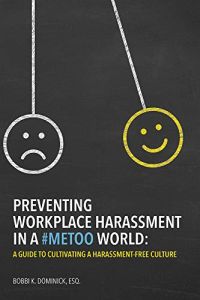Join getAbstract to access the summary!

Join getAbstract to access the summary!
Bobbi Dominick
Preventing Workplace Harassment in a #MeToo World
A Guide to Cultivating a Harassment-Free Culture
SHRM, 2018
What's inside?
Deal with workplace harassment decisively and create a culture that prevents it.
Recommendation
Seventy-five percent of employees experience one or more forms of harassment over the course of their career, from teasing and bullying to sexual assault. Toxic corporate cultures that tolerate bad behavior ultimately drive away customers, employees and potential future workers. The costs to organizations – in terms of money, reputation and culture – are staggering. The impact on victims is unconscionable. Employment lawyer Bobbi Dominick brings decades of experience to bear on the subject in her comprehensive guide to managing workplace harassment of all types.
Summary
About the Author
Bobbi Dominick practices employment law and is an internationally known expert in workplace harassment prevention and response. She advises leaders across all sectors in employment and HR matters.



















Comment on this summary